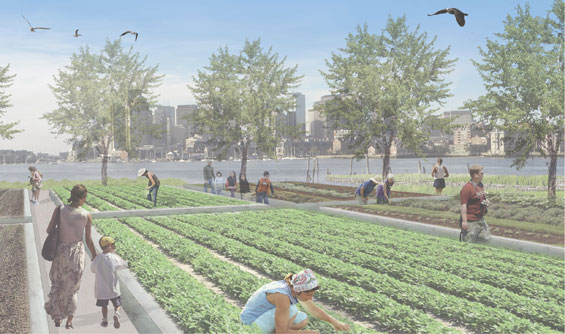
The human race is faced with a challenge. As the population continues to grow our reliance on the planet’s natural resources is threatened by overuse and neglect. In order to endure, humanity must
discover new ways to restore the balance between people and natural systems. This presents an invaluable opportunity to rethink how we design our communities and interact with the landscape.
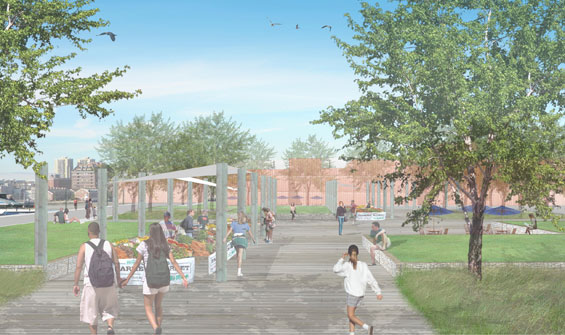
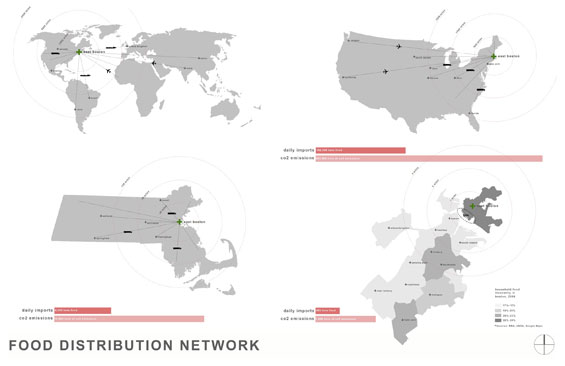
The project I present here examines the issue of sustainability in East Boston and proposes a framework for the development of urban communities focused on sustainability and long-term production and growth. East Boston like many other urban communities around the world is dealing with critical issues including climate change, pollution, contamination, job security, and food accessibility. On East Boston’s waterfront, post-industrial lots lie vacant and inaccessible and serve as reminders of a period of industrial production. This project attempts to restore a new type of production on the waterfront based on sustainable urban agriculture as a catalyst for growth. Integrating productive natural processes with urban communities has the ability to foster stewardship, education, social and economic growth.
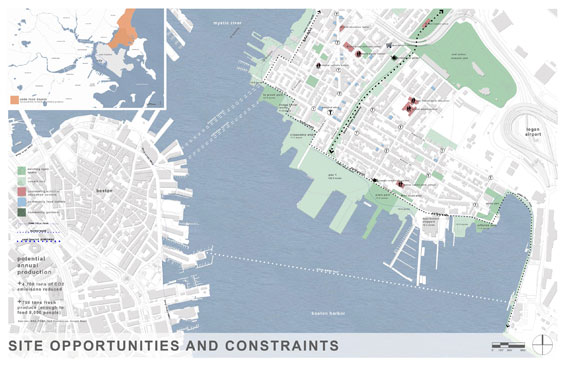
This project proposes to solve an impending food crisis while simultaneously rejuvenating East Boston’s waterfront by creating Boston’s first urban CSA farm serving as a model for future sustainable development and to reconnect people’s relationship with the environment. The design is based on implementing a flexible framework with the ability to change over time based on various levels of production. The framework is based on a productive module of 40’x80’ overlaid over the existing conditions and history of the site. The module has the capability of reducing 25 tons of CO2 emissions annually, providing fresh produce to 20 people annually1, and providing housing for more than 20+ people. The module is a benchmark for tracking productivity and establishing a new form of development on the waterfront. Inspired by East Boston’s historic street grid and piers, the grid framework maintains order between nature and manmade systems establishing a new sustainable infrastructure and provides the framework for a series of phases toremediate the site, implement urban agriculture, set the stage for development, and adapt to future issues like climate change.
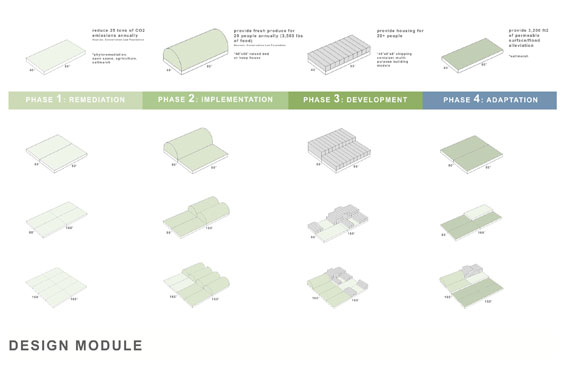
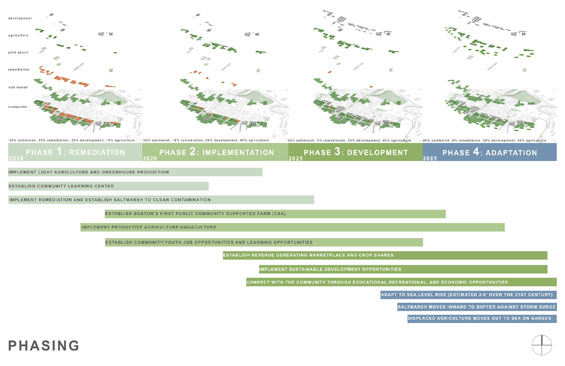
Phase 1: Remediation addresses post-industrial contamination on site and in Boston Harbor by restoring historic saltmarsh, using phytoremediation to cleanse contaminated soil, and in-situ remediation to address the most contaminated areas.
Phase 2: Implementation is the process of implementing agriculture on site once most contamination has been remediated. Agriculture will consist of raised planters, year round greenhouses, and aquaculture dispersed on site according to previous contamination levels.
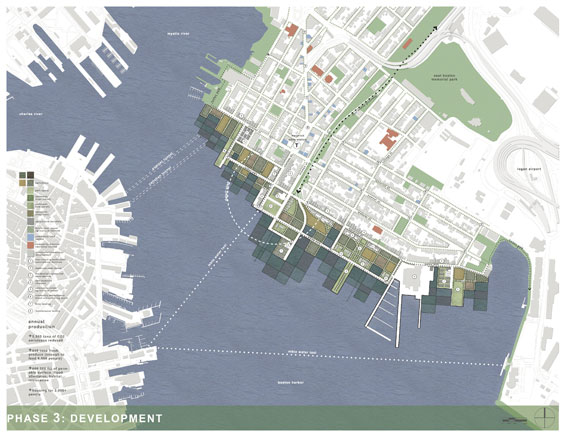
Phase 3: Development will set the stage for sustainable development to move into the site once agriculture has matured and the site has been completely remediated. Development will take the form of modular shipping container housing and commercial spaces in the form of restaurants, small businesses, and food outlets taking advantage of harvests on site.
Phase 4: Adaptation will address the issue of sea level rise over the 21st century. Sea level rise is expected to be anywhere between 2’-5’ over the next 100 years. In order to protect against extreme high tides and storm surges the sites flexible modular framework will adapt to changing sea levels by incorporating more saltmarsh and moving agriculture out to sea on new floating platforms/barges.
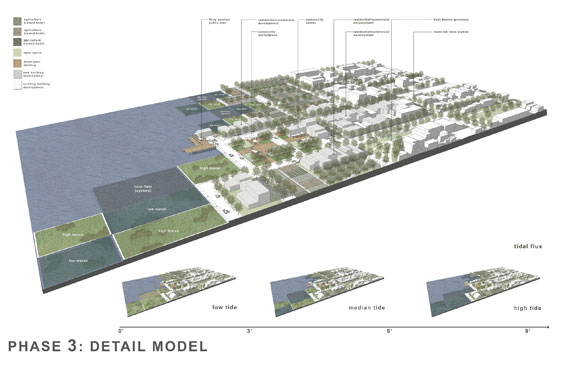
The detail plan of phase 3 focuses on the community agriculture center/marketplace, which is the focal point of the masterplan. Located at the intersection of the Maverick MBTA station, the East
Boston Greenway, the Boston Harborwalk, and a proposed water taxi between Downtown and East Boston. The community center links to an outdoor marketplace/mixed use park serving primarily as an outdoor farmer’s market and food truck venue for residents and visitors. At this junction proposed modular shipping container residential and commercial development is alongside raised beds, hoop houses, and the saltmarsh. Productive ecology mixes with modular development stimulating revived activity on the waterfront along with economic growth. The center’s focus will be on educational, volunteer, and employment opportunities while the outdoor marketplace will host farmer’s markets throughout the week. The overall design not only solves the impending food problem in East Boston, but addresses contamination, environmental degradation, sea level rise, and accessibility. The flexibility, light development, and modular framework of the site will allow for future adaptation and the renewed agricultural and industrial presence will revive the community.
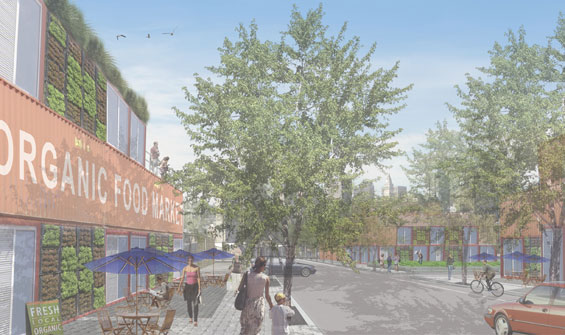
STUDENT PROJECT | Growing East Boston: A Sustainable Framework for Implementing Urban Agriculture | Edward Adams
Designer: Edward Adams, MLA student at the Boston Architectural College
Created: Spring 2013
Location: East Boston, MA


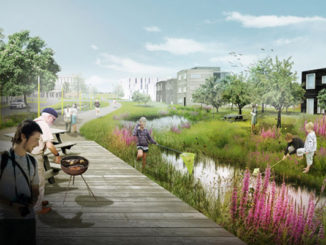
Comments are closed.